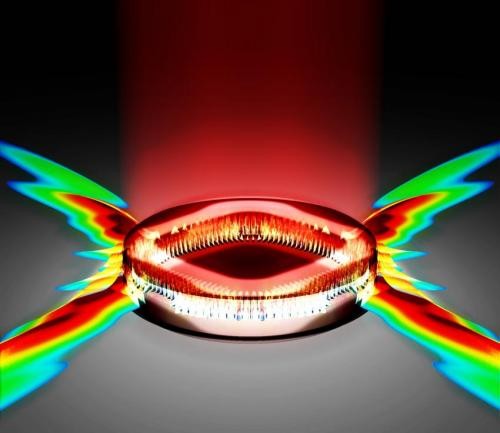Reducing Power Emitted by Lasers may Increase its Output
| Marc Maligalig | | Oct 27, 2014 08:55 AM EDT |
(Photo : Omer Malik, Tureci Group, Princeton University)
Engineers from Princeton University have demonstrated that restricting the amount of power in specific regions within a laser increases its output by many orders of magnitude,
This discovery could potentially create more energy-efficient and sensitive lasers, and control the spatial pattern and frequencies of light emissions.
Like Us on Facebook
"It's as though you are using loss to your advantage," said graduate student Omer Malik, an author of the study, along with Li Ge, assistant professor at the City University of New York, and Hakan Tureci, assistant professor of electrical engineering at Princeton.
Scientists said limiting the power delivered results in most of the physical space inside the laser absorbing light rather than producing it. The laser's optimally efficient region has less competition from less efficient portions, which makes it shine far more brightly than previous estimates suggested.
Produced by computer simulations and mathematical calculations, the results still need to be verified in actual experiments with real lasers. The team said their findings represent a new understanding of the basic processes that govern how lasers emit light.
"Distributing gain and loss within the material is a higher level of design -- a new tool -- that had not been used very systematically until now," Tureci said.
At the core of the laser, there is a material that gives off light when energy hits it. If low amounts of energy are added, the light is "incoherent," meaning it consists of a combination of colors, or wavelengths.
When more energy is added to the system, the material promptly attains a "lasing" threshold when it gives off coherent light of a specific wavelength.
The entire surface of the material, however, does not emit the laser light. If the material is arranged in a disc-shaped pattern, the light could possibly come from a ring close to the edge of the shape. When more energy is provided, more patterns are emitted.
The modes or patterns produced when energy is added begin to sap energy from each other and interact. Because of the competition, modes that need more energy may never reach their thresholds.
By directing power only to a specific location on the material where the mode comes from, researchers were able to pick particular modes that require less energy.
Tagslaser, Lasing, Princeton University, power, Current, Electricity, Energy, Mode
©2015 Chinatopix All rights reserved. Do not reproduce without permission
EDITOR'S PICKS
-

Did the Trump administration just announce plans for a trade war with ‘hostile’ China and Russia?
-

US Senate passes Taiwan travel bill slammed by China
-

As Yan Sihong’s family grieves, here are other Chinese students who went missing abroad. Some have never been found
-

Beijing blasts Western critics who ‘smear China’ with the term sharp power
-

China Envoy Seeks to Defuse Tensions With U.S. as a Trade War Brews
-

Singapore's Deputy PM Provides Bitcoin Vote of Confidence Amid China's Blanket Bans
-

China warns investors over risks in overseas virtual currency trading
-

Chinese government most trustworthy: survey
-

Kashima Antlers On Course For Back-To-Back Titles
MOST POPULAR
LATEST NEWS
Zhou Yongkang: China's Former Security Chief Sentenced to Life in Prison

China's former Chief of the Ministry of Public Security, Zhou Yongkang, has been given a life sentence after he was found guilty of abusing his office, bribery and deliberately ... Full Article
TRENDING STORY

China Pork Prices Expected to Stabilize As The Supplies Recover

Elephone P9000 Smartphone is now on Sale on Amazon India

There's a Big Chance Cliffhangers Won't Still Be Resolved When Grey's Anatomy Season 13 Returns

Supreme Court Ruled on Samsung vs Apple Dispute for Patent Infringement

Microsoft Surface Pro 5 Rumors and Release Date: What is the Latest?










